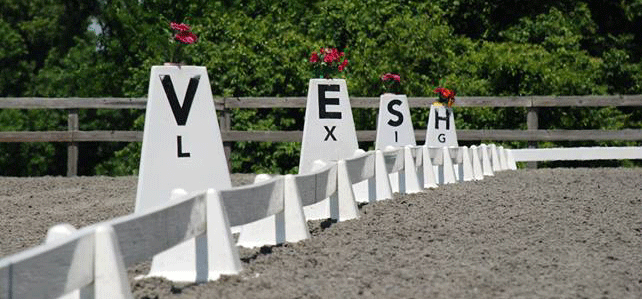Now that we have reviewed 15- and 10-meter circles, you can start to apply these figures to various exercises, as we did with the 20-meter circles in previous months. Here are two great exercises that combine many of the tools in your toolbox, but feature the smaller circles.

15-Meter Figure Eights
Recall how we combined two 20-meter circles to form a figure eight (Feb. 2014) and apply the same rules to figure eights made from two 15- and 10-meter circles. Let us start with the 15-meter circle figure eight:
1. Begin in walk to allow yourself time to become familiar with the geometry.
2. On the right rein, ride a 15-meter circle at B.
3. Make it a point to hit the far quarterline at the halfway point of your circle to ensure correct geometry.
4. Once you have completed three-quarters of your circle, turn onto a left-rein circle, with a curved line in the new direction, as you would when riding a 20-meter figure eight.
5. Ride a curved line to the track, hitting 15 meters past B and 3 meters past R.
6. When you return to the point where you picked up your second circle, you will briefly be parallel to the short side. Then return to the right circle.
7. Ride a curved line to B and you have completed your 15-meter figure eight.
Notice how your knowledge of arena geometry will help you as you navigate the 15-meter figure eight. Once you are comfortable with this figure, try it in trot. As always, place cones down if you feel confused by the measurements.
10-Meter Figure Eights
This figure is a more physically challenging exercise because the circles are smaller and require more bend, but certainly less taxing on the brain. Because the arena is 20 meters wide, we can ride a 10-meter figure eight between B and E with ease.
Here is how to ride a 10-meter figure eight in a way that also prepares you for the half-circle-to-half-circle movement seen in First Level, Test 1:
1. Begin in walk to allow yourself time to become familiar with the geometry.
2. On the right rein, ride a 10-meter circle at B.
3. Aim to hit your halfway point at X.
4. Over X, when you are parallel to the long sides of the arena, pick up your 10-meter circle left.
5. Ride a curved line to E on the left rein.
6. Continue your left circle to X.
7. When you are momentarily parallel to the long sides over X, pick up
the second half of your 10-meter circle right.
Once you are comfortable with the figure, try it in trot. Again, if you struggle with the geometry then set out cones. In this case, a cone on either side of X is a nice way to mark the center of your figure eight.
As you work these two exercises, remember to apply the principles of all figure eights: attach two circles with a moment of straightening as you change the rein to the second circle. Remember that you should always maintain your geometry and never ride short diagonal lines to get yourself onto the new circle.
To read more from the Dressage 101 series, click here.
This article originally appeared as part of a monthly series on Dressage 101 topics in the 2014 issues.
In addition to her role as contributing editor at the magazine, Hilary Moore Hebert is also a professional dressage trainer with clients from green to FEI. A USDF bronze and silver medalist, as well as “L” Education Program graduate, she owns and operates Moore Hebert Dressage at Alsikkan Farm in Germantown, Maryland.












